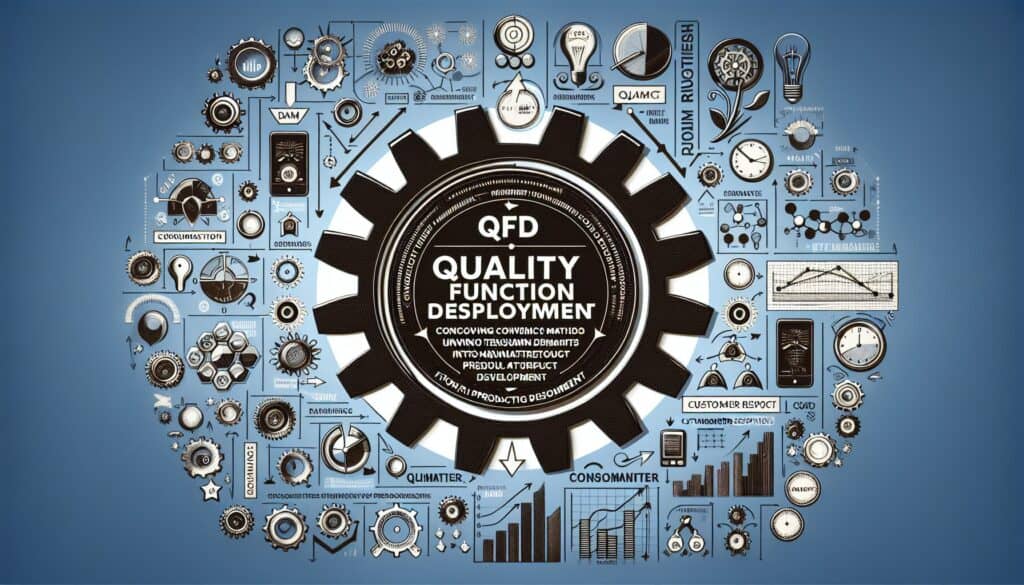Traduire les exigences du client (Voice of the Customer) en caractéristiques techniques spécifiques pour conception de produits et le développement.
- Méthodologies : Clients et marketing, Idéation, Conception de Produits
Déploiement de la fonction qualité (QFD)

Déploiement de la fonction qualité (QFD)
- Collaboration interfonctionnelle, Expérience client, Conception pour la fabrication (DfM), Pensée conceptuelle, Développement de produits, Assurance qualité, Déploiement de la fonction qualité (QFD), Gestion de la qualité
Objectif :
Comment il est utilisé :
- Une méthodologie structurée, utilisant souvent une série de matrices (comme la "Maison de la qualité"), pour s'assurer que les besoins des clients sont clairement définis et déployés à tous les stades de la planification, de la conception, de l'ingénierie et de la fabrication du produit.
Avantages
- Axé sur le client, il garantit que les produits répondent aux besoins ; il hiérarchise les efforts de conception en fonction de l'importance du client ; il améliore la communication interfonctionnelle et le travail d'équipe ; il réduit les délais et les coûts de développement en obtenant de bons résultats dès la première fois.
Inconvénients
- Peut être complexe et prendre du temps, en particulier pour les produits complexes ; nécessite une collecte et une analyse importantes des données ; la matrice "Maison de la qualité" peut devenir difficile à manier ; le succès dépend de l'exactitude des données COV et de l'engagement de l'équipe.
Catégories :
- Clients et marketing, Ingénierie, Conception de Produits, Gestion de projet, Qualité
Idéal pour :
- Veiller à ce que les besoins des clients soient le principal moteur des décisions de conception et de développement tout au long du cycle de création du produit.
Quality Function Deployment (QFD) is often applied in sectors such as automotive, aerospace, consumer electronics, and healthcare, where the intricate relationship between customer expectations and technical specifications is paramount. This methodology is typically employed in the early phases of product development, allowing teams to gather and analyze customer voice data through surveys, interviews, and market research, leading to a clearer articulation of customer needs. Participants typically include cross-functional teams composed of product managers, engineers, designers, marketing specialists, and production staff, ensuring a holistic approach that draws on diverse expertise throughout the design process. One of the primary applications of QFD is in the creation of the “House of Quality,” a matrix that visually represents the interplay between customer requirements and engineering characteristics, facilitating prioritization based on the significance of these customer needs. Subsequently, this leads to more focused design efforts, aligning resources toward high-impact features and minimizing the risk of costly revisions later in development. As projects advance, QFD can be revisited to accommodate changes in customer preferences or technological advancements, cementing its role in maintaining alignment with market demands. Companies leveraging QFD benefit from reduced time to market and lower development costs, as the structured approach encourages efficient communication and collaboration, ultimately driving higher customer satisfaction and loyalty.
Principales étapes de cette méthodologie
- Identify customer requirements using Voice of the Customer (VoC) techniques.
- Prioritize customer needs based on importance and urgency.
- Translate customer requirements into technical specifications.
- Develop a relationship matrix to link customer needs with engineering characteristics.
- Assess the technical difficulty of achieving each engineering characteristic.
- Determine competitive benchmarking to evaluate performance against competitors.
- Create a prioritized action plan for design, development, and engineering efforts.
- Review and update the QFD matrices regularly throughout the product lifecycle.
Conseils de pro
- Involve customers directly during the QFD process, such as through surveys or focus groups, to better capture their true needs and preferences.
- Use benchmarking against competitors to identify gaps in your offerings and align your product features based on comparative customer importance.
- Regularly update QFD matrices throughout the project lifecycle to reflect changing customer expectations and technological advancements.
Lire et comparer plusieurs méthodologies, nous recommandons le
> Référentiel méthodologique étendu <
ainsi que plus de 400 autres méthodologies.
Vos commentaires sur cette méthodologie ou des informations supplémentaires sont les bienvenus sur le site web de la Commission européenne. section des commentaires ci-dessous ↓ , ainsi que toute idée ou lien en rapport avec l'ingénierie.
Contexte historique
1962
1970
1972
1980
1980
1986
1986
1960
1963
1970
1980
1980
1980
1986
1987
(si la date est inconnue ou n'est pas pertinente, par exemple "mécanique des fluides", une estimation arrondie de son émergence notable est fournie)















Articles Similaires
Questionnaires sur les troubles musculo-squelettiques
Tests à plusieurs variables (MVT)
Analyse de régression multiple
Systèmes de capture de mouvement
Méthode MoSCoW
Test de la médiane de Mood